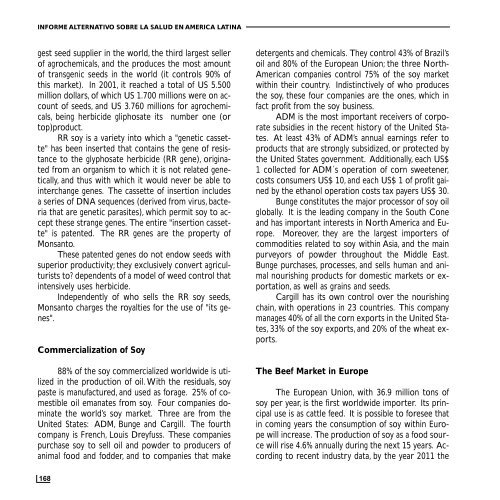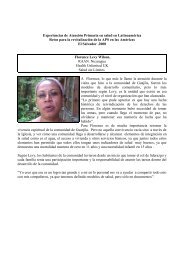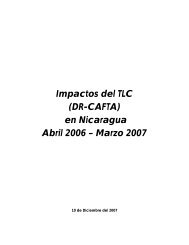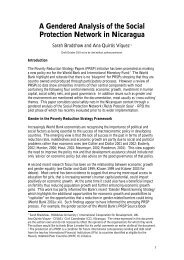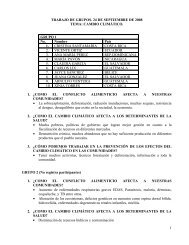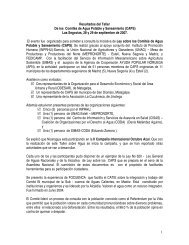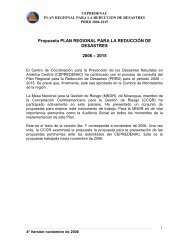Download - CISAS | Centro de Información y Servicios de AsesorÃa ...
Download - CISAS | Centro de Información y Servicios de AsesorÃa ...
Download - CISAS | Centro de Información y Servicios de AsesorÃa ...
You also want an ePaper? Increase the reach of your titles
YUMPU automatically turns print PDFs into web optimized ePapers that Google loves.
INFORME ALTERNATIVO SOBRE LA SALUD EN AMERICA LATINAgest seed supplier in the world, the third largest sellerof agrochemicals, and the produces the most amountof transgenic seeds in the world (it controls 90% ofthis market). In 2001, it reached a total of US 5.500million dollars, of which US 1.700 millions were on accountof seeds, and US 3.760 millions for agrochemicals,being herbici<strong>de</strong> gliphosate its number one (ortop)product.RR soy is a variety into which a "genetic cassette"has been inserted that contains the gene of resistanceto the glyphosate herbici<strong>de</strong> (RR gene), originatedfrom an organism to which it is not related genetically,and thus with which it would never be able tointerchange genes. The cassette of insertion inclu<strong>de</strong>sa series of DNA sequences (<strong>de</strong>rived from virus, bacteriathat are genetic parasites), which permit soy to acceptthese strange genes. The entire "insertion cassette"is patented. The RR genes are the property ofMonsanto.These patented genes do not endow seeds withsuperior productivity; they exclusively convert agriculturiststo? <strong>de</strong>pen<strong>de</strong>nts of a mo<strong>de</strong>l of weed control thatintensively uses herbici<strong>de</strong>.In<strong>de</strong>pen<strong>de</strong>ntly of who sells the RR soy seeds,Monsanto charges the royalties for the use of "its genes".Commercialization of Soy88% of the soy commercialized worldwi<strong>de</strong> is utilizedin the production of oil. With the residuals, soypaste is manufactured, and used as forage. 25% of comestibleoil emanates from soy. Four companies dominatethe world’s soy market. Three are from theUnited States: ADM, Bunge and Cargill. The fourthcompany is French, Louis Dreyfuss. These companiespurchase soy to sell oil and pow<strong>de</strong>r to producers ofanimal food and fod<strong>de</strong>r, and to companies that make<strong>de</strong>tergents and chemicals. They control 43% of Brazil’soil and 80% of the European Union; the three North-American companies control 75% of the soy marketwithin their country. Indistinctively of who producesthe soy, these four companies are the ones, which infact profit from the soy business.ADM is the most important receivers of corporatesubsidies in the recent history of the United States.At least 43% of ADM’s annual earnings refer toproducts that are strongly subsidized, or protected bythe United States government. Additionally, each US$1 collected for ADM´s operation of corn sweetener,costs consumers US$ 10, and each US$ 1 of profit gainedby the ethanol operation costs tax payers US$ 30.Bunge constitutes the major processor of soy oilglobally. It is the leading company in the South Coneand has important interests in North America and Europe.Moreover, they are the largest importers ofcommodities related to soy within Asia, and the mainpurveyors of pow<strong>de</strong>r throughout the Middle East.Bunge purchases, processes, and sells human and animalnourishing products for domestic markets or exportation,as well as grains and seeds.Cargill has its own control over the nourishingchain, with operations in 23 countries. This companymanages 40% of all the corn exports in the United States,33% of the soy exports, and 20% of the wheat exports.The Beef Market in EuropeThe European Union, with 36.9 million tons ofsoy per year, is the first worldwi<strong>de</strong> importer. Its principaluse is as cattle feed. It is possible to foresee thatin coming years the consumption of soy within Europewill increase. The production of soy as a food sourcewill rise 4.6% annually during the next 15 years. Accordingto recent industry data, by the year 2011 the168


